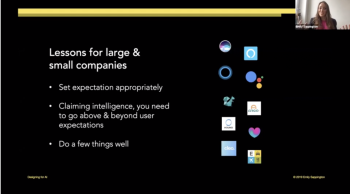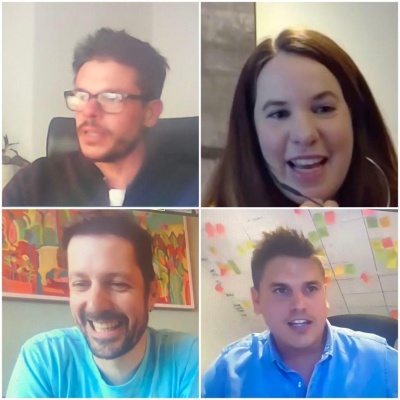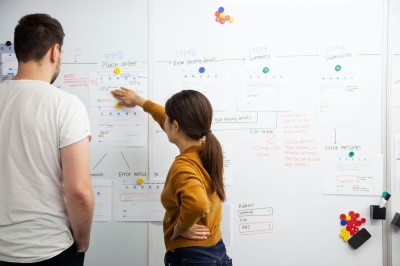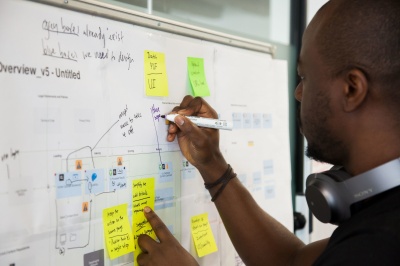
Graphite’s CX Sessions - Creating better digital

- Customer Experience
On the 8th and 9th of July, Graphite Digital ran their very first CX Sessions via Zoom. The CX Sessions were designed to inspire business owners, leaders, product designers and start-ups who want to deliver better CX. We curated a line up of thought leaders that were already creating great products and shaping the future of CX. Our line-up of speakers shared the different methods they use to drive and deliver better digital experiences, inspiring attendees to create better products and experiences for their customers.
In this post we take a look back at the sessions and revisit some key quotes and learnings from our inspiring line up of thought leaders.
Evening one:
Designing with AI - Setting User Expectations | Emily Sappington, Product Director for Voice and Conversational applications at Babylon Health (talk starts at 00:04:39)
Future AI - Innovation in the context of AI | Adam West, Head of Marketing at Satalia (talk starts at 00:35:40).
Designing for AI; Setting User Expectations
Emily Sappington - Product Director for Voice and Conversational Applications at Babylon Health
Emily Sappington focuses on creating natural ways for people to access affordable healthcare at Babylon Health. Emily has spent the bulk of her career in the United States designing Windows and Cortana for Microsoft across devices, particularly Natural Language & UI interactions with the assistant.
In her talk, Emily explored and shared some best practices for designing for AI in both large and small organisations. She discussed setting appropriate expectations when designing for AI and shared how drawing on human interaction models can help designers know what to expect when people encounter their AI product.

Key quotes from Emily's talk:
“When talking about AI, it’s so critical to talk about user expectations because artificial intelligence is a loaded term.”
“AI isn’t a destination, it's a means to an end, it’s a tool that you employ.”
“We use what humans think is smart in other humans and apply this to technology.”
“When we encounter something that we don’t know if it's alive or not, what's the first thing we do? We test, we evaluate. That first interaction, that first impression is what sets up our expectations for the future interactions we’ll have with it. I see startups all the time that invest in AI and machine learning but maybe don’t invest in the front-end engineering that ensures it’s a seamless user experience and has zero glitches.”
“If you lose your users at the first instance, then they won’t discover the intelligence.”
“At my last start up, we looked at the data and realised that if we had any failures in the first 10 instances, 10 websites that someone visited using our extension, they likely didn’t trust us in the future.”
“As a product person, I really believe in the crawl, walk, run approach. What that means is you build your product over time but I think it’s also important to set your users expectations along the way and to bring them along for the ride with you.”
“Too often I see companies claiming they can do lots of things before they can, maybe because they’re small startups and they’re trying to get investor funding. But remember that your users are just your users, they’re not your investors.”
“It’s useful for us as designers and product folk to understand the ability of the AI and design around it.”
“Always set expectations appropriately. If you’re going to claim intelligence, know that you need to go above and beyond user expectations.”
“Do a few things very well. If you’re going to go above user expectations it helps to not boil the ocean and try to do every single scenario under the sun, but to just scope out a small area where you can really excel and succeed and try to conquer all that you can in it.”
Future AI - Innovation in the Context of AI
Adam West - Head of Marketing at Satalia
Satalia is a 100 person enterprise AI company in London. Satalia’s client list includes Tesco, 3 Mobile, BBC, Prezzo, and DFS. Adam regularly speaks about the future of AI - myth-busting the hype and describing what impact it will have on individuals, business and society. Adam is the author of "Alexa, build me a brand", a paper on the impact of AI on branding and has done over 60 keynotes for organisations such as Google, Barclays, Society Générale, L&Q, GSK, BP, Pearson, the House of Commons, The US Trademark Office, CineEurope and ImpactAI.
In his talk, Adam discussed innovation in the context of AI and cut through the hype to focus on the future of AI and the impact it will have on individuals, businesses and society. He questioned whether typical organisational structures are set up to attract, retain and empower the right talent. Finally, he touched on the use of AI and organisational psychology within organisations, including how it's being used to decentralise decision making and even set salaries.
Key quotes from Adam's talk:
“Throughout COVID we’ve worked with Tesco to increase their delivery slots from around 600,000 home delivery slots offered to customers a week to now over 1 million. Last year we found out we saved them just over 11 million miles in travel, just purely by more efficient routing and scheduling using AI.”
“When we talk about data-driven decision making it has to have three components. The first of which is getting your data. Storing, managing, processing, contextualising data in some way. And this is technologies like databases or data lakes or infrastructure, APIs, sensors, internet things. Anything that gets in data.”
“The second is then using that data to make some sort of prediction about the world. This is technologies like machine learning and data science.”
“The third component which is often neglected from what we see in the industry is optimisation. This is essentially the leveraging of those insights or the leveraging of those predications to actually allocate the resources and make decisions. It is technologies like optimisation or decision science or operations research. From what we understand, most organisations think they have machine learning problems, but in reality they don’t, they have decision making problems.”
“As an organisation, we advise small and large companies that we think there is going to be a renaissance in optimisation over the coming years as people realise the value is actually about combining machine learning predictive technologies with decision making optimisation type technologies.”
“Obviously there are a few different definitions of AI. One that is weak but popular is essentially getting machines to imitate or do what humans can do or what's only been previously possible in the domain of humans. And the reason that we think this, is because humans are the most intelligent thing that we know in the universe. But humans can’t solve these types of problems, so there are instances that humans aren’t particularly intelligent, so benchmarking machine intelligence against human intelligence isn’t always the smartest thing to do.”
“We’d argue that AI is actually goal directive adaptive behaviour. What we mean by this is, for a system to be truly intelligent it has to have a goal, it has to have an objective, it has to be able to behave but crucially it has to be adaptive in production environments in real time and without the aid of a human.”
“For a system to be truly intelligent it has to do it in real time, in a production environment without the aid of a human.”
“If you give a system some data and it makes a decision, it has to be able to recognise whether that decision was good or bad, adapt its own internal model of the world, and if you give the same data then it’d make a different decision.”
Evening two:
Industry Panel - Creating better digital customer experiences for people
Mark Morris, Multi-Channel Lead at Novo Nordisk | Chris Lomas, Global Products Leader- AI & Data Science at Mercer | Maeve O’Gorman, Head of Digital at Vhi Healthcare| Thomas Michalak, Creative Director at Graphite Digital | Hosted by Rob Verheul, Managing Director at Graphite Digital.
Our panel all have extensive experience of delivering large CX transformation projects. In this session, our inspiring panel of brand leaders shared their experiences and tips on how to overcome difficulties, create a successful CX and how you can kick start your brand’s CX transformation.

Key quotes from the panel discussion:
Chris Lomas - “I think expectations are higher in a crisis, and I think going forward expectations are going to be even higher as people now know what is possible.”
Thomas Michalak - “Our clients talk a lot more about CX than they used to. I think the change probably happened once companies and brands realised that quite a lot of people are associating the offline with the online and that both have a big impact on the brands identity."
Mark Morris - “If you can embed customer experience thinking culturally as high as you can in your organisation and get it pushed down, I think that’s very important.“
Maeve O'Gorman - “I would say the downside of the last few months has been a bit of a culture of impatience. Generally, it's felt like there has been expectations that have gotten a lot higher, people are very impatient and just expect things to be there right now, and don’t care about issues in getting it done. There just doesn’t seem to be the forgiveness there. We’ve had to build things really quickly, respond really quickly. I don’t know if we’ve had the time to get everything right, but it's really important for us now that we take a phase two, we stabilise, we take a really good look at what's working, what's not working, listen to our customers and move forward.”
Chris Lomas - “We’ve probably spent a couple of hundred hours now just listening to people about their pain points, about organising knowledge and really emphasising and getting under the skin of what the real pain point is. That’s really important. And then you use all of that data, stories, empathy and understanding to then tell your story to convince your stakeholders.”
Thomas Michalak - “One thing that hasn’t really changed is that there is quite often focus on the success parts of customer experiences and we tend to not want to talk much about the not so successful parts of customer experience because as businesses we don’t really like those kinds of failures. So I think that there are still areas where we don’t put as much focus and in those moments I think this is where you can really lose customers, when things are bad and there is a crisis.”
Mark Morris - “I always find that people will recall a poor customer experience quicker than they will a good customer experience.”
Maeve O'Gorman - “Now (coming out of lockdown) we’ve done things very quickly and there is a downside of that which means sometimes you don’t take the time to stabilise, you don’t have the time to do as much pre-testing, as much pre-verification and sometimes you find out when you put it out there to the customers you’re getting a more live set of feedback than you might normally be used to.”
Thomas Michalak - “If you’re in a research team or in a design team, quite often it can be hard to understand the business side. It’s just trying to remember to link your objectives to the business objectives because you need to bridge that gap between business and design and research so that business people can understand that you’re not just banging on about the users because that's what your supposed to do, there is actually a real link and a real value for the business.”
Maeve O'Gorman - “I’d say the one thing we need to keep going from this crisis mindset is to keep listening really carefully and then try to adapt as the data trends come through to say okay customers' needs are evolving, customers need different things."
Mark Morris - “Although it (the pandemic) has been panic driven and we've been running around like headless chickens, I think it has been a positive catalyst for change in terms of not just doing digital but being digital.”
Thomas Michalak - “People love new, people love exciting, and people get bored. Sometimes in older companies people like the idea of it but when they then have to put the money in to change it, suddenly everyone says ‘Do we really need to do this?’. I think that’s quite a big challenge for everyone and something that involves a lot of politics.”
Mark Morris - “I think stakeholder mapping is a nice exercise to do to understand who is within your sphere of influence within your organisation and map where they currently sit with their understanding of customer experience, understand where you need them to be and then work out how you get them there.”
Graphite work with healthcare and pharmaceutical companies to design, build and improve digital customer experiences. Feel free to reach out via the form below to find out how we could help your vision for customer experience become a reality.
Want more on customer experience?


CX Design - Customer Journey Mapping for Innovation
- Customer Experience

Behavioural psychology & customer experience - social identity
- Customer Experience